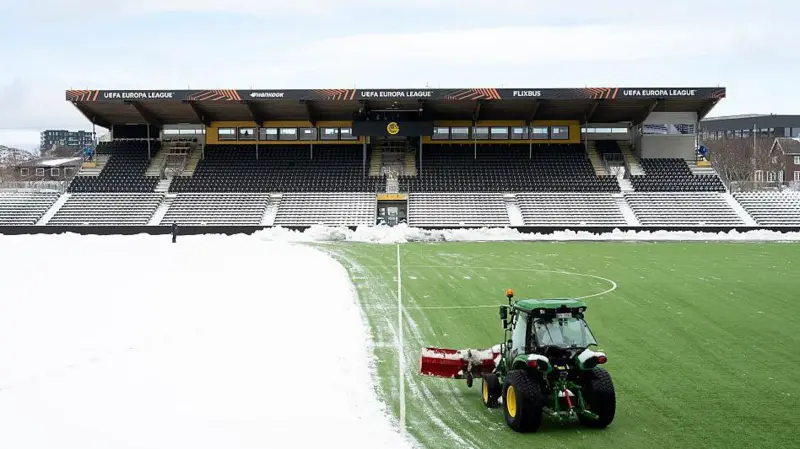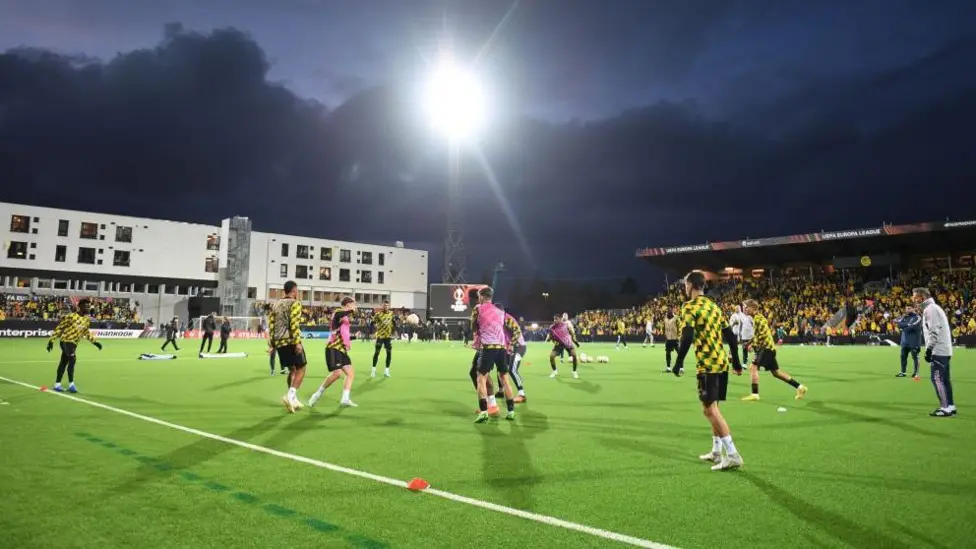The biting winds howling off the Norwegian Sea carry whispers of past European giants humbled at the Aspmyra Stadion as Tottenham prepare for their most unconventional challenge this season.
Nestled 200 kilometers north of the Arctic Circle, Bodo/Glimt’s modest 8,500-capacity ground has become a graveyard for continental ambitions, with Lazio’s recent 2-0 quarterfinal defeat joining Roma’s infamous 6-1 Conference League humiliation in the annals of Arctic football shocks.
Now Ange Postecoglou’s Spurs must navigate this frozen gauntlet protecting a 3-1 first-leg advantage, aware that history and conditions conspire against them.
Unlike Lazio’s blizzard-ravaged visit last month, Tottenham will encounter relatively mild 5°C temperatures – positively balmy by Bodo standards.
Yet the coastal winds whipping through the stadium’s open design create unpredictable microclimates mid-game, turning routine passes into adventure football. “The ball dances like a mad thing when that Arctic wind grabs it,” confessed Bodo defender Jostein Gundersen, whose team consciously weaponizes their inhospitable home.
The artificial pitch adds another layer of complexity – passes skid 15% faster on the synthetic surface according to UEFA studies, while the ball’s bounce behaves erratically compared to natural turf.

Tottenham’s solitary experience on artificial grass this season – January’s labored 3-0 FA Cup extra-time win at sixth-tier Tamworth – exposed vulnerabilities Postecoglou must address.
Midfield metronome Pierre-Emile Højbjerg noted how the surface “changes the geometry of the game,” requiring earlier decision-making and adjusted touch.
Bodo’s Odin Bjortuft smirked when recalling how visiting defenders “look like they’re skating” when chasing his pacy attackers on the slick surface.
Yet there are blueprints for success. Arsenal’s 1-0 victory here in 2022 demonstrated that technical quality can overcome environmental factors when paired with pragmatic adaptation.
Bukayo Saka’s winning goal that night came from precisely the type of cutback move Postecoglou favors, exploiting the surface’s true bounce in the penalty area. The Gunners’ meticulous preparation – including specialized footwear and adjusted passing drills – offers lessons Spurs would be wise to heed.
Tactically, Tottenham must temper their usual expansive game without sacrificing attacking intent. The wide areas become particularly treacherous in windy conditions, suggesting inverted wingers like Dejan Kulusevski could prove more effective than traditional touchline huggers.
Set pieces take on added importance – 38% of goals scored on artificial pitches in this season’s Europa League have come from dead balls, compared to 29% on grass.
Psychologically, Postecoglou must convince his players that Bodo’s reputation outweighs their actual threat. While the Norwegian champions remain unbeaten in 11 European home games against non-Scandinavian opponents, their squad’s total market value (£38m) amounts to less than half of James Maddison’s transfer fee.
The absence of suspended striker Albert Grønbæk, scorer of 12 goals this campaign, further weakens their attacking arsenal.

For Tottenham’s traveling supporters making the 1,500-mile journey, the Arctic adventure represents one of world football’s most unique away days. Those braving the trip will find a town where reindeer outnumber people and the midnight sun creates surreal 24-hour daylight during summer months.
The Aspmyra’s intimate confines promise an atmosphere more akin to a Viking war chant than typical European football ambiance.
As the teams take the field under the eerie glow of the Arctic twilight, Tottenham’s mettle will be tested beyond mere footballing ability.
Can they silence the war drums of the Glimt faithful? Adjust their rhythms to the surface’s staccato beat? Withstand the psychological warfare of opponents who’ve turned environmental adversity into their greatest weapon?
The answers will determine whether Spurs book their ticket to Dublin’s final or become the latest victims of Europe’s most improbable fortress. One certainty remains – in the Arctic Circle, conventional football wisdom freezes solid. Only those who adapt will survive.
